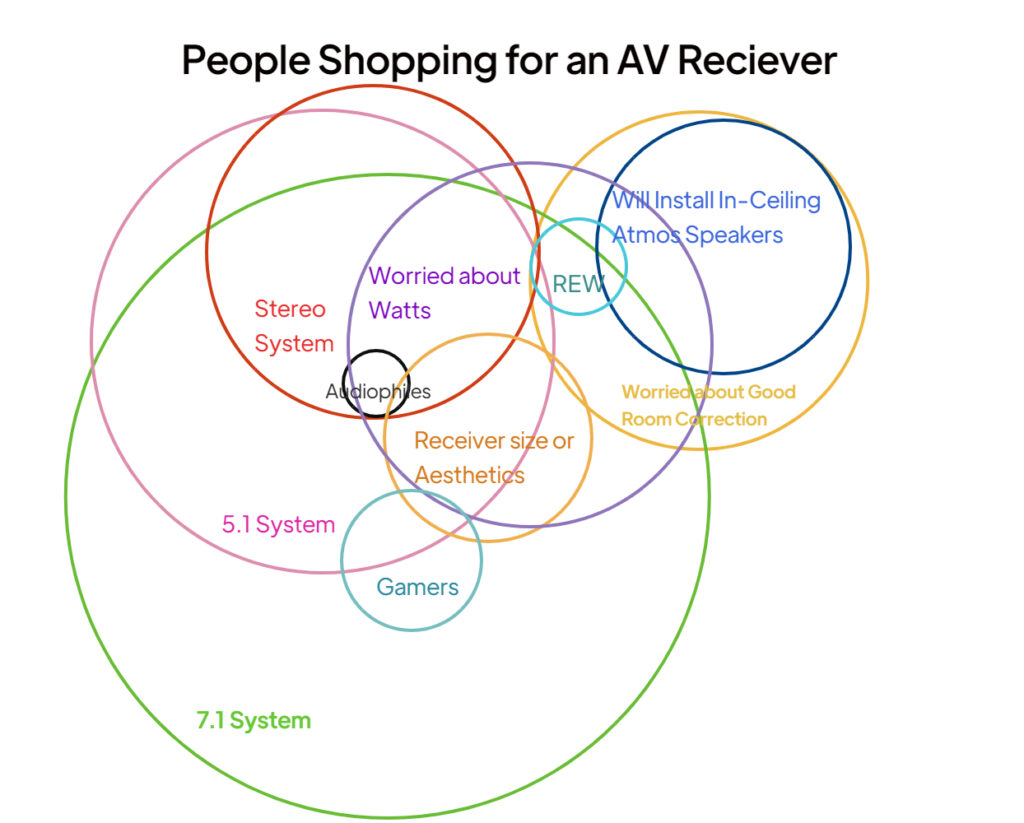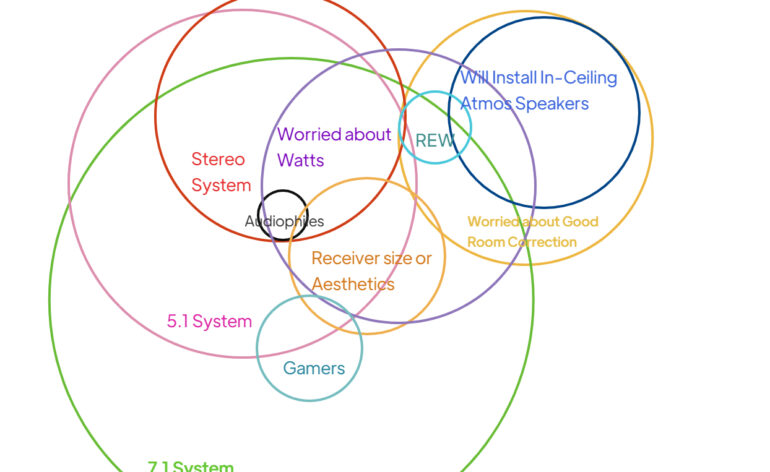AV Receiver Buyers’ Venn Diagram
We often get questions about AV receivers. Specifically, why someone can’t get an AV receiver that only does what they want (and nothing else). Of course, since this fictional AV receiver does less than other AV receivers, it should also cost less. Less functionality should equate to fewer parts which equates to a lower price. Makes sense. Except it totally doesn’t. To understand this more thoroughly, we must look at our (admittedly not-totally-accurate) Venn Diagram of AV receiver buyers.

Breaking Down the Circles
The first consideration when someone starts shopping for an AV receiver is the number of channels. By and large, most people have a number in mind (2, 5.1, 7.1, etc.) with the idea that they “might” expand in the future. Fewer people actually start off with, “I’m only ever going to have X number of speakers in my system for the rest of my life.” It does happen, but not as often. That’s why the Stereo, 5.1, and 7.1 circles in the AV receiver buyers’ Venn Diagram overlap so much. They may plan on only starting with one number of speakers but they entertain the dream of adding more.
They won’t, but they dream about it.
Next, we have some of the internal circles. The audiophiles obviously live in two-channel land with a major concern on watts and a minor one on the size/aesthetics of the receiver. People worried about aesthetics or size often worry about watts as well as they understand that making an AV receiver smaller or look a specific way may reduce its power. There is also a small group of gamers out there that care about the latest HDMI 2.1 features that really only apply to them.
Lastly, we have the room correction crowd. These people overlap completely with the REW users and Atmos installers but don’t really dip very far into the Stereo-only crowd. The fact is that once you start looking at AV receivers with more than seven channels, you are getting good room correction whether you want it or not. Then it becomes a question of which room correction is best.
Selling to the Circles
If you are an AV receiver manufacturer, you have to think about who is going to buy your product. The key is to capture as many circles as possible with a product that costs as little as possible. If you make a stereo-only AV receiver, then you’ve left out a lot of those circles. Even if you focus on 5.1, there are a ton of buyers out there that won’t look at your product. The more of the circles you can capture, the more of that product you can make. The more you make, the more you can haggle down the prices on the components and slim down your margins. This allows you to lower the price to the consumer because you know how many you can sell and how much you’ll likely make on each sale.
It makes the most sense to offer a range of AV receivers that trade sticker price for features. You can capture a ton of buyers by offering a 7.1 AV receiver with a big watts rating, HDMI 2.1 features, and reasonable aesthetics for the least amount of money. But to capture everyone, you need all the features, the maximum possible channels (for the Atmos crowd), the best room correction (or a promise of an option in the future), and tons of power. That, of course, will be expensive.

How Does This Affect Price
We’ve created this Venn Diagram of AV receiver buyers to illustrate why the AV receiver market is the way it is. Look at the size of the circles. The size doesn’t just illustrate the overlap between the different groups, but also tries to estimate the size of the buyers’ pool. Say you are a buyer that only needs two HDMI inputs (no gaming concerns), you don’t care about room correction or watts, and you only want to run a 5.1 system. That sliver of consumers is very small.
From the manufacturer’s perspective, the maximum number of units they could potentially sell of such an AV receiver is very small. This means they couldn’t count on selling a lot of volume in order to make money on each sale. They couldn’t negotiate prices down on the components so the AV receiver would be more expensive to make. Suddenly the “does less so should cost less” argument falls apart. Because the market is so small, this makes the product cost more!
Take Away
Looking at our AV receiver buyers’ Venn Diagram should make it clear why there are such similar tiers from different manufacturers. They’ve all done the calculations and they’ve decided how they think they can capture the most interest with each of their products. This also explains why boutique offerings cost so much more. It isn’t because they are better (even though that is often what they claim), but because they are of interest to many fewer potential buyers. This makes them more expensive to produce and requires higher profit margins per sale. This also explains the phenomenon where a pre-pro that has all the same features as an AV receiver will cost more. It seems like it should cost less because of the removal of the amplifier section. But, because it doesn’t appeal to as many people, its price will be higher to compensate.
Once you tip over into the ultra-expensive “audiophile” offerings, then a different phenomenon rears its head. If it isn’t stupid expensive, then it can’t be good. But we’ll leave that discussion for another article.


